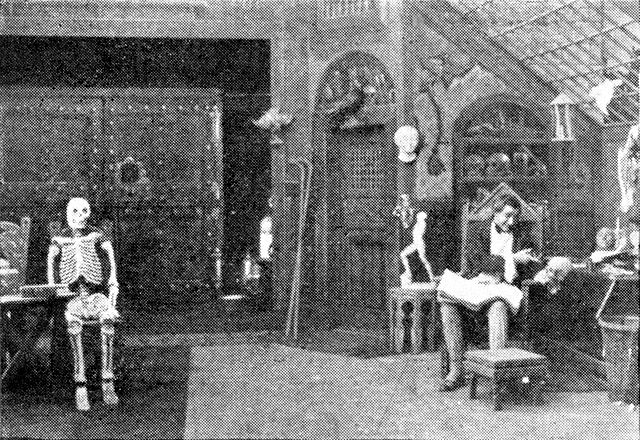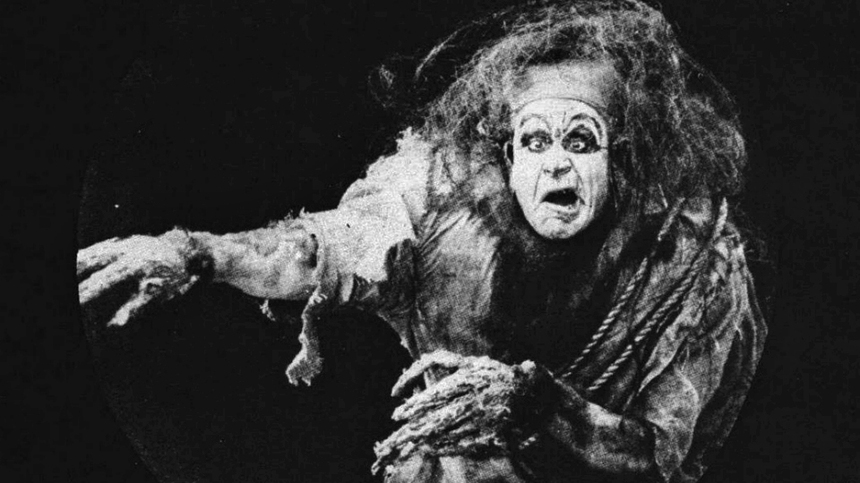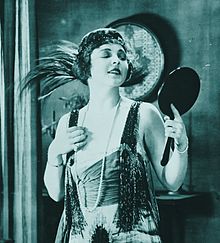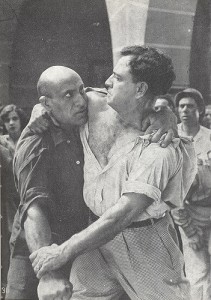The supposedly first Frankenstein movie of 1910 turns the monster metaphysical rather than physical, but the gruesome special effects in the creation scene is fleshy enough. We also take a peek at two lost silent Frankenstein films. (6/10)
Frankenstein (1910, USA). Written and directed by J. Searle Dawley. Based on Mary Shelley’s novel Frankenstein (1818). Starring: Charles Ogle, Augustus Phillips, Mary Fuller. Produced by the Edison Company. IMDb score: 6.5 Tomatometer: N/A. Metascore: N/A.
+ Life Without a Soul (1915, USA) and Il mostro di Frankenstein (1920, Italy), both lost films.

Although the Americans and the Edison Company was a bit slow to jump on the sci-fi bandwagon, mostly leaving it to the French and the Brits, they ultimately did so in style in 1910 with the much fussed about adaptation of Frankenstein – often cited as the first Frankenstein film. Or did they? In this trimmed down and altered version on Mary Shelley’s novel, not much science remains.
Granted – Mary Shelley herself was pretty vague on the science part, but nonetheless claimed that Victor Frankenstein’s creation was achieved through scientific means, although verging on alchemy. The novel was also, among other things, a cautionary tale about man playing god with science. In the 1910 film, there is no science in the mix other than that Victor Frankenstein is presented as a scientist. The creation of the monster is more akin to magic and alchemy, and we are told through inter-title cards that it is the ”dark thoughts” of Frankenstein that turns the creature into a monster. The monster is also projected more as a metaphysical than a physical being. In this sense the 1908 version of Dr Jekyll and Mr Hyde, made by the rival Selig Polyscope Company, was more sci-fi than this Frankenstein. Anyway, since this is the first(?) movie outing of a monster that has since inhabited so many science fiction films, I have chosen to include it in the blog.

Here’s some background. The Edison Company was owned by the same Thomas Alva Edison who held over 1 000 US patents in his name and was highly influential in the invention of the light bulb, the movie camera, the x-ray, the phonograph, and revolutionized electrical distribution. He also happened to create the largest film company in the USA. In 1909 the film branch of his company was the most profitable of all his ventures – and a lot of the money came from patents that other companies had to pay for. But the Edison Company’s monopoly was shrinking, partly due to the popularity of foreign film makers, such as the special effects magician Georges Méliès, and partly due to the fact that ever more American film companies were springing up with their own patents. This Edison solved by creating a ”movie trust” with many of the larger companies, effectively creating a monopoly on the US market.
Another problem was that the growing film medium was catching the attention of religious and other groups, that were starting to voice their opposition to this new ”vulgar medium”. This did not bode well for the movies, and Edison didn’t want to fight moral groups, especially since he had just built a huge, expensive studio in Bronx, NY. On the other hand he knew that horror and shock sold the most tickets. So now there was a conundrum. There would have to be a new major production to celebrate both the studio and the trust, that would sell tickets, but not be too lewd for the critics. The answer: Frankenstein.

Well, a very watered down Frankenstein, that is. In addition to pleasing the critics, Edison as a scientist naturally didn’t want to paint a bleak picture of science. Hence the change from science to metaphysics. Edison also promised the public that this 14 minutes long ”epic” had been stripped of all the horror bits, and was presented as a moral play. That wasn’t exactly true, though, and the film was censored or banned in some places, mostly due to the pretty gruesome creation scene.
This is how it goes: In 14 short minutes we get the bare bones of the story. The young Victor Frankenstein goes to college – and ”after two years he has discovered the secret of life”, the inter-title cards simply tells us. Did he then attend a frat party, or just go for a cup of coffee, before discovering the origins of the universe? Anyway, then follows the most remembered part of the film: the creation of the monster, done very well in reverse-photography. The film makers first build up a skeletal being, then add flammable material to make a lifelike dummy, which they set of fire and let it burn down. Then they reverse the film, making it appear as though it is built up from scratch, rather than burned down. Add a single skeletal arm that is constantly flapping up and and down, and the effect is both gruesome and hopelessly, unintentionally comedic. The following film deals with the monster as a manifestation of Frankenstein’s doubts and dark thoughts, and not until he loves his fiancée unconditionally and has purged all impure thoughts, does the monster disappear into a mirror.

Charles Ogle as the monster – an unkempt cross between Ozzy Osborne, Nosferatu and Quasimodo – has since become an iconic figure, and it is obvious the Edison company did not spare expenses to make the movie. The creation scene must have been painstaking to make at the time, although it does seem like a pretty simple process in retrospect. But it was quite possibly the most impressive special effect of its kind to date, even outdoing the wizardry of Méliès (although the giant octopus in his partly lost 1907 film 20 000 Leagues Beneath the Sea was almost equally impressive). Frankenstein also features some pretty clever mirror effects, although one gets the feeling that more could have been made of it. On the downside is the fact that a substantial portion of the film is taken up with pretty meaningless wanderings in and out of rooms, and a lot more could have been done with the sets. Now it very much resembles a theatrical Kammerspiele with pretty unimaginative rooms, outside of which we never move.

The film was directed by J. Searle Dawley, who had a reasonably successful career at the Edison Company. The title role was played by Augustus Phillips, by all accounts a well employed bit part player throughout his 10 year long contract with the company. Mary Fuller, as Frankenstein’s bride, had a short, but successful career as both an actress and a screenwriter. Failing to bring the studio any money with her last films, she was kicked out in 1917, suffered several nervous breakdowns, withdrew from the public, and spent the 25 last years of her life admitted to a psychiatric institution, where she died alone in 1977. The monster, Charles Ogle, went on to become a respected character actor both on and off screen, perhaps best known as Long John Silver in the 1920 version of Treasure Island and for his lesser role in The Ten Commandments from 1923. Some sources name Thomas Edison as the producer of the film, but there is little evidence that he had much to do with the production, although the films is often referred to as “Thomas Edison’s Frankenstein“.

The film gained cult status because it was considered a ”lost film” for many years. This was the fate for many early films, as the value of preserving and archiving films was not always understood. It was officially labelled as a lost film in 1950, when the preservation of old American films started, but was rediscovered in a private collection in the seventies.

Two other silent Frankenstein films were made: the first feature-film length Frankenstein movie called Life Without Soul (1915), directed by Joseph W. Smiley for Ocean Pictures, and an Italian version called Il mostro di Frankenstein (1920 or 1921) (Frankenstein’s monster) directed by Eugenio Testa. Both are considered lost films, unfortunately.
The 1915 US version seems to have been modestly successful, and I get the impression that British Percy Standing did a memorable turn as “the monster”, a soulless man modeled out of clay. There are a number of production stills available, and a fairly detailed knowledge of the plot and production of the movie. The film seems to have followed the main plot of the novel reasonably closely – a scientist (William Cohill) itching to find the secrets of life creates a synthetic man, who in turn goes haywire, and demands the doctor make him a mate. When he refuses, the creature, called “The Brute Man”, kills the scientist’s sister (Pauline Curley) on her wedding night and flees to Europe, where the scientist chases him across the continent, finally killing him. However the story was set in the US in modern times, and the doctor’s name has been changed to Frawley, rather than Frankenstein.

There are also a few larger differences. The film has a frame story in which Dr. Frawley, a medical student, discovers “the fluid of life”. Later that evening he falls asleep in his armchair, reading a copy of Mary Shelley’s Frankenstein. In a classic cop-out ending Frawley wakes up in the very same chair after the adventure is over – it was all a dream. This ploy was often used to counter criticism about films having a bad influence on the youth or about misleading the audience: we all know that everything is possible in a dream, and having immoral dreams is not the same as committing immoral acts. In fact, immoral dreams may well be our subconscious warning us about immoral acts – and Dr. Frawley indeed destroys his fluid of life after waking up.
Another blatant difference from the source novel is that the creature isn’t a cadaver, stitched together or otherwise. Instead Frawley dreams about animating a clay statue with his life fluid. In this sense the movie was inspired by the Jewish myth of the golem, which had been turned into a German film called Der Golem, released to cinemas in January 1915, and was screened in the US with the title The Monster of Fate.
At the film’s release, Variety wrote a mixed review: “the Ocean folks have done well with it, despite numerous inconsistencies, but there is no reasonable limit to the possibilities of such a subject. Their scenario is at times rather vague, but the novelty of the idea for filming will be sure to create a healthy demand for the picture if intelligently boomed. No theatre will go far wrong by showing Life Without Soul“.

Life Without a Soul was inhabited by what one might call “working but not necessarily very successful actors”. The one exception is Lucy Cotton (playing Frawley’s fiancé), who had a brief turn as a star on Broadway in the 1910’s. She also appeared in 12 films between 1910 and 1921, none of them especially well known. Because of her stage fame she was still closely followed by the press, which wasn’t less interested because of her marriage to millionaire publisher Edward Russell Thomas. Thomas passed in 1926, leaving her with a 27 million dollar inheritance. After that she had a number of failed marriages, the last one to a member of the Russian Tsarist family, Prince Vladimir Eristavi-Tchitcherine, and henceforth she insisted on being called “Princess”. Cotton committed suicide by sleeping pills in 1948.

Pauline Curley grew up on stage, and toured the vaudeville circuit with her family from age 5. She made her movie debut in 1913, only 10 years old, which means she was no more than 12 or 13 when she played Dr. Frawley’s sister (getting married!) in 1915. In 1917 she and her mother moved to Hollywood, looking for greener pastures, but Curley never managed to climb the career ladder quite like she had hoped. She got off to a fair start in her young age with a supporting role in Herbert Brenon’s The Fall of the Romanoffs (1917), and reached her peak as the leading lady in the popular Douglas Fairbanks swashbuckler Bound in Morocco, where she played a harem girl being rescued by Fairbanks. In 1919 she had a bit-part in King Vidor’s directorial debut The Turn in the Road, and she was soon relegated to Z-movies, especially cheap westerns, where she had a handful of leading lady roles before retiring from the scene in 1929.
A third actor worthy of mention is Percy Standing, if only for the fact that he came from the prominent British theatre family the Standings, his father was the renowned stage actor Herbert Standing, and many of his siblings and children also became actors. Percy Standing was a respected character actor and even had a few leading man roles, but like so many silent era actors, his career was cut short with the introduction of talking movies. He is perhaps best known today for his supporting role in the historic musical The Flame of Love (1930), famous for its interracial kiss between the movie’s stars Anna May Wong and John Longden, which was cut from the US theatrical release. Another successful film was Bonds of Love (1919), where he was the leading man opposite Pauline Frederick.

The Italian version (1920 or 1921, depending on the source) Il monstro di Frankenstein was intended as a full-length movie, but was savagely cut by Italian censors at the time of its release and finished at 39 minutes. Despite this, the movie seems to have been hugely successful, as collectors have found promotional posters from several countries, promoting screenings as long as six years after the movie was released. All that remains from the film is a single still (above) depicting Italian strongman Umberto Guarracino as a bald-headed monster strangling a victim, film posters and a French program sheet.
Director Eugenio Testa directed a few dozen films, but hasn’t made any huge impression on Italian film history. The showrunner was producer and lead actor Luciano Albertini, a muscled former circus athlete, who was the Jean-Claude van Damme to Maciste’s Arnold Schwarzenegger of early Italian cinema, best known at the time for numerous outings as the biblical hero Samson. Born Francesco Vespignani in 1882, Albertini took his stage name from a successful trapeze troupe he performed with for several years, the Albertinis. His trademark trick was something called The Death Spiral, which also became the title for his breakthrough movie, a circus film, in 1917.

Albertini’s big break came thanks to Bartolomeo Pagano, a muscled stevedore who was hired to play the role of Maciste the slave in the 1914 epic movie Cabiria. The character proved so popular that Itala Film immediately made a spinoff featuring a hero called Maciste, and Pagano took the name, first for his stage name, and later changed it legally. With numerous Maciste films over a span of 14 years, Maciste became something of an Italian superstar, with fame that crossed borders. After he retired, other actors took over the role. Producer Ernesto Pasquale at production company Pasquale e C wanted to cash in on the strongman-fad created by the Maciste films, and in 1918 he hired Albertini to play the role of Samson in the film Sansone contro i Filistei (Samson vs. the Philistines), getting not only the chiseled body of a dock worker, but an acrobatic sword-and-sandal hero. In 1919 Albertini founded his own production company Albertini Film, and produced and starred in seven more highly popular Samson films, or Samsonette films.

Albertini was joined by fellow actress Linda Albertini, who played an Amazonian female hero in her own right in the Samson & Samsonette movies. Linda Albertini was allegedly Luciano’s second wife, and may or may not have been a part of his former trapeze troupe. Whichever way, her true identity has has eluded film buffs. We do know that the Albertinis were at least a couple for many years.
In 1920 Albertini tired of the Samson films, and once decided to take on more prestigious challenges, starting with Il mostro di Frankenstein – which by all accounts seems to have been a great success. For his most ambitious undertaking, he set out to develop Michele Zevaco’s novel Il ponte dei sospiri into a four-part film series with the same name; The Bridge of Sighs (1921, Il ponte dei sospiri). It was a costly, lavish production set in the golden age of the Venetian empire, retelling a story reminiscent of The Count of Monte Christo, with Albertini in the lead role. According to contemporary critics, The Bridge of Sigh was without rivalry Albertini’s finest moment. However, after WWI Italian cinema was in a deep crisis due to foreign competition, leading to in-wars in the Italian movie industry. In 1921 Albertini Films was excluded from the Italian Film Union, and all 10 000 meters of film were confiscated. Fortunately, through help from Albertini’s old friend Ernesto Pasquale, the film was able to get released through Pasquale e C.

Disillusioned and burned by the Italian film industry, Albertini did what many Italian filmmakers and actors had done and moved out of the country. He made his way to Germany, where he produced and starred in highly successful films, making him yet again a much beloved film star, known for his breathtaking action sequences and acrobatics. In 1924 he was invited over to Hollywood by Universal to star in a 15-part film serial called The Iron Man. However, it flopped, and audiences failed to connect with the Italian acrobat, and seemed to root for the American villain. Despite what some may write on the internet today, this was not the reason for Albertini’s quick return to Germany, as he left US soil with great flair, accompanied by not one, but two private airplanes (one held a camera team documenting his journey), to start work with a four-film contract with Phoebus-Film, three months before the first episode of the serial had even premiered.
One of his later films was called Der Mann auf dem Kometen (1925), or the man on the comet, which looks to have been a science fiction film. and according to his IMDb bio he starred in a serial in Tinseltown. He even made an appearance in Aleksandr Dovzhenko’s Soviet classic Arsenal (1929). However, with the advent of sound, the style of films Albertini made fell out of fashion, and no doubt he would have had trouble re-inventing himself as a speaking actor in Germany. His worsening alcoholism didn’t help him, and after his last movie in 1932, he moved back to Italy, where he lived out his days in a mental asylum.

The other strongman of the Il monstro di Frankenstein, Umberto Guarricano, had a much less celebrated career, but appeared in over a dozen films, including another sci-fi movie, the German adaptation of H.G. Wells’ pamphlet The Island of Dr. Moreau, called Die Insel der Verschollenen (1921, review). He also played a number films opposite the famous Maciste. Guarricano’s best known turn in the Maciste films was as Pluto, the king of Hell in Maciste in Hell (1925, Maciste all’Inferno).
Janne Wass
Frankenstein, 1910, USA: Written and directed by J. Searle Dawley, based on Mary Shelley’s novel Frankenstein. Starring: Charles Ogle, Augustus Phillips, Mary Fuller. Produced by Thomas Edison for The Edison Manufacturing Company. Creature make-up: Charles Ogle.
Life Without a Soul. 1915, USA. Directed by Joseph W. Smiley. Written by Jesse J. Goldburg, based on Mary Shelley’s novel Frankenstein. Starring: William W. Cohill, Percy Standing, George De Carlton, Lucy Cotton, Pauline Curley, Jack Hopkins, David McCauley, Violet de Biccari. Produced by John I. Dudley for Ocean Film Corporation.
Il mostro di Frankenstein, 1920/1921, Italy. Directed by Luciano Albertini. Written by Giovanni Drovetti, based on Mary Shelley’s novel Frankenstein. Starring: Luciano Albertini, Umberto Guarracino, Linda Albertini, Aldo Mezzanotte. Produced by Luciano Albertini for Albertini Film.

Leave a comment